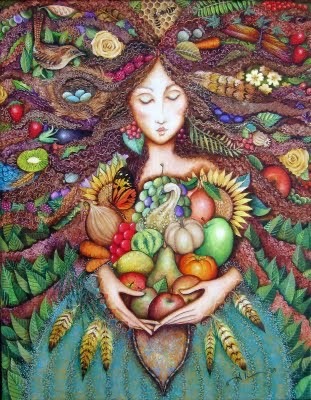Starts 1st August to 31st October.It is a Gaelic festival marking the beginning of the harvest season. Historically, it was widely observed throughout Ireland, Scotland and the Isle of Man.
It is a time of harvest & abundance. In Irish mythology, Lughnasa festival is said to have derived from a celebration, originally held by the God ‘Lugh’ as a funeral feast and athletic competition in commemoration of his mother ‘Taitlin’. Poor Taitlin was said to have died of exhaustion after completing the small task of clearing the plains of Ireland for agriculture.
It marked the end of summer and the beginning of the harvest season, and on that day the first meal of the year’s new food crop was eaten. The chief custom was the resorting of the rural communities to certain heights or water-sides to spend the day in festivity, sports and bilberry-picking.
Along with the gathering of fruit and flowers and the ritual cleansing of animals, another Bilberry Sunday tradition was a special meal made with the first of the new crop of the potatoes. These were gathered by the head of the household, who might also bless the fields with Holy Water, and made into a traditional meal for the family – in some areas colcannon, in others served with cabbage and bacon.
How can you celebrate Lughnasa?
Decorate your altar: Using the colors of the season is a sacred way to honor the day. This includes a combination of oranges, reds, and dark yellows. You could also add some dried grains & berries to celebrate the start of the harvest season.
Bake bread: The center of Lughnasa revolves around baking bread. To have an abundant harvest season. It’s the perfect way to bring families together to celebrate the harvest and home. Traditional Lughnasa feasts include each member taking turns breaking bread around the table. Consider doing the same with your family or by yourself.
Herbs for this Season
Yarrow: Yarrow has taken on different meanings and symbolism throughout the centuries. It’s been known to be a herb that casts away evil spells and hexes. People believe that stringing it across the doorway will prevent evil spirits from entering their home. To use yarrow in your own Lughnasa practice, place it around your neck as a form of protection. In Ireland it was called the herb of the seven cures on account of it many great healing virtues & was one of the favourite remedies of the fairy doctors against ‘Fairy stroke’ or Evil Eye! It was frequently sewn up into clothes to prevent disease.
Vervain: The use of vervain can be traced back thousands of years for its role in spiritual and ceremonial services. In the Druidic tradition, many members believed vervain had supernatural powers to assist in getting in touch with the other side. Use vervain essential oil as a blessing for your loved ones who need an extra health boost. The dried herb is scattered around the home as a peace-bringer & is worn to calm the emotoins.
Mint: Another herb close to the Druids, mint is known for its healing and protection powers. During Lughnasa, mint was used to attract abundance into one’s life. One of the best ways to use mint is during a tea ritual, such as making a drink that includes mint leaves. This is a great way to honor your body and bless it with seasonal health. Fresh mint laid on our alter will call good spirits to be present & aid you in magic.
Blackberry: Blackberry was considered to be sacred to the old pagan deities of Europe & was used in worship. The leafs are used in spells for wealth & abundance. Collect the berries before Samhain (October 31st) the lore behind this is that a fairy called Puca or Pooka spat on all the berries on Halloween & made them inedible.
I will be making an incense of the above to burn over the weekend to welcome in abundance in all forms.
Green Blessings – Laura x

